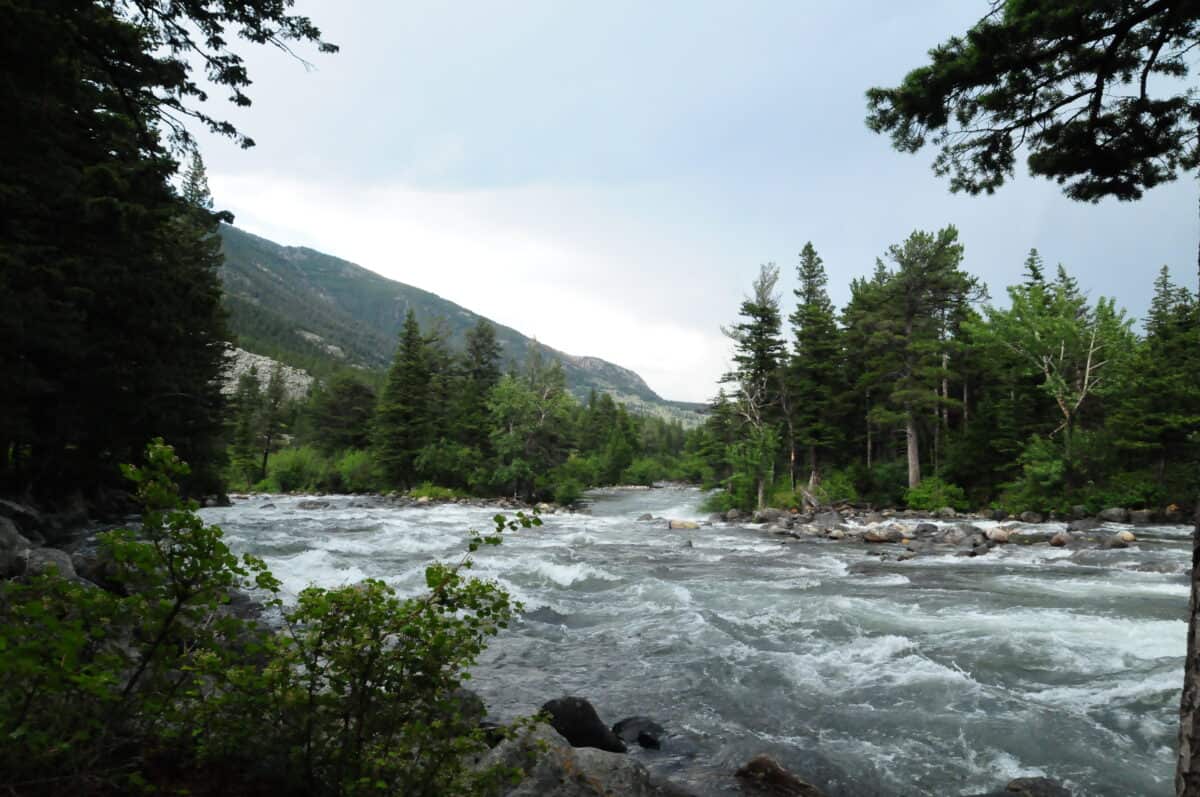
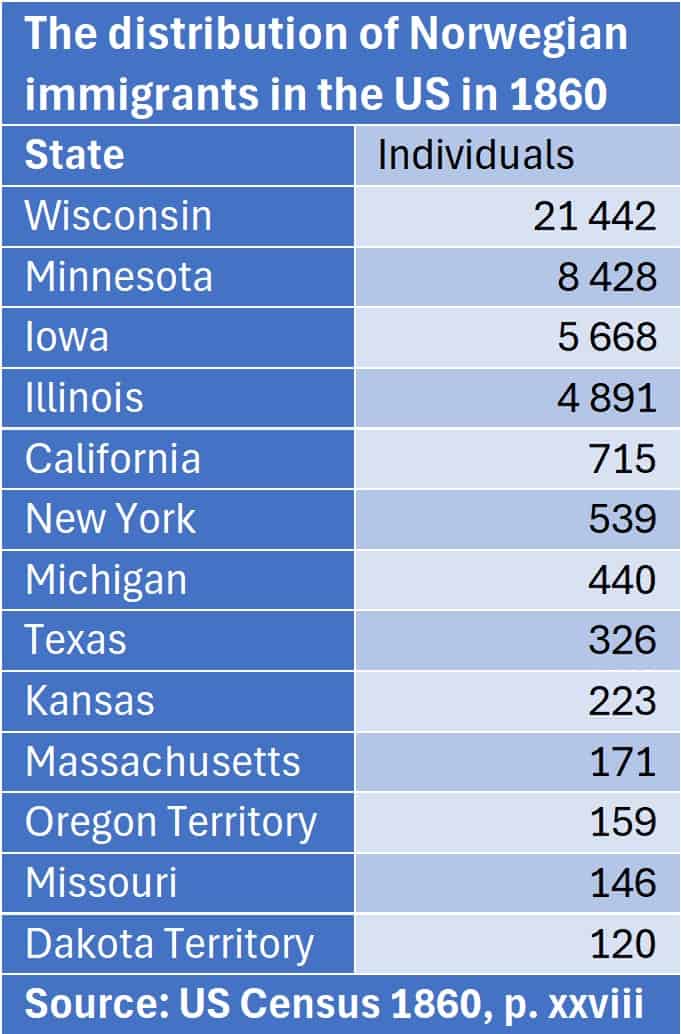
It is high time to tell the story of early Norwegian immigration to Montana. In his excellent book from 1958, Kenneth Bjork, West of the Great Divide. Norwegian Migration to the Pacific Coast, 1847-1893, wrote that important research themes such as the “movement of immigrants from region to region in the New World have been largely overlooked.”[2] In “West of the Great Divide” he tried to trace and “interpret the early trek of Norwegian immigrants to the vast stretches of land along the Pacific coast.” In his view the trek was a result of “economic, social, and political developments in the Mississippi Valley”. Bjork tried to reconstruct much of the story of the Norwegian immigrants who moved west of the “Great Divide”, the Rocky Mountains.
Generally, few white people lived in Montana Territory before the Civil War. In addition to Indian trade and missionary activity, some small agricultural settlements sold their surplus to homesteaders passing through the territory on their way to Oregon.[4] When the Civil War broke out in 1861, very little economic activity was conducted by people of European ancestry in Montana.
Gold discoveries in the 1860s led to the settlement of Montana Territory
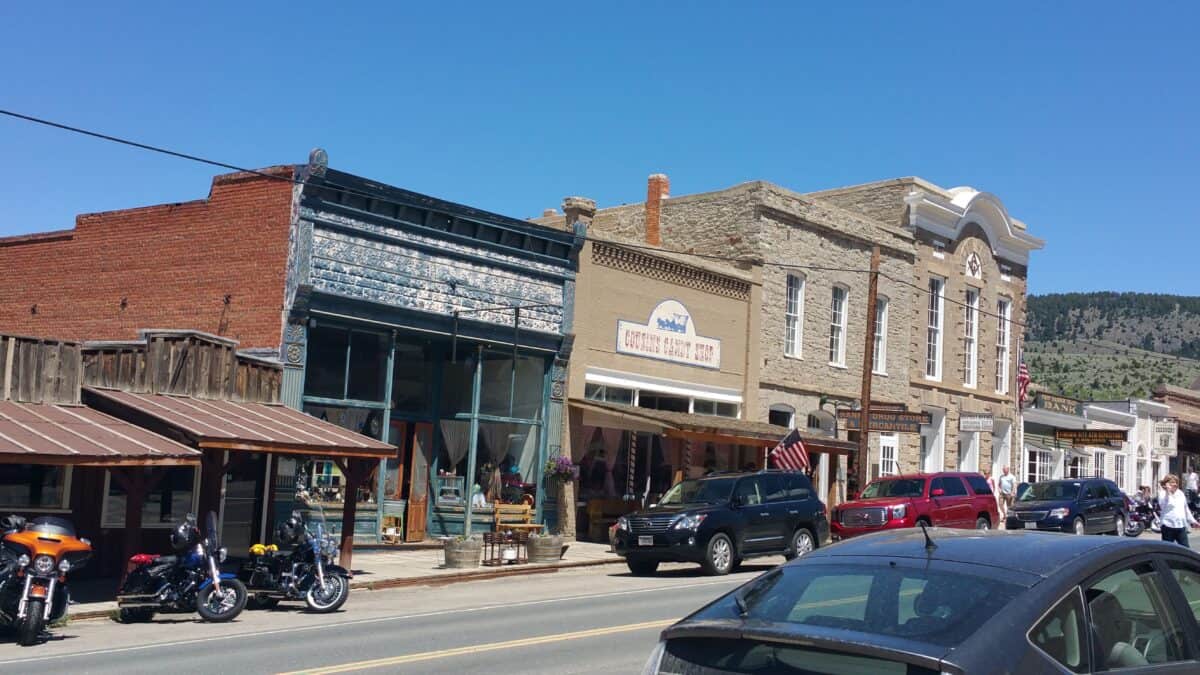
When the gold discoveries became known in the early 1860s, thousands of men traveled to the Montana goldfields. The journey to Montana was complicated, expensive and time consuming. The gold fields could be reached either from the south, from California and Colorado, or from Oregon in the west. People who traveled by way of Salt Lake City had to solve the challenge of finding a way north through 450 miles of arid land. Montana could be reached from the west by steamboat up the Columbia River in Oregon and then along overland trails.[5] The completion of the Mullan Road made transport much easier.
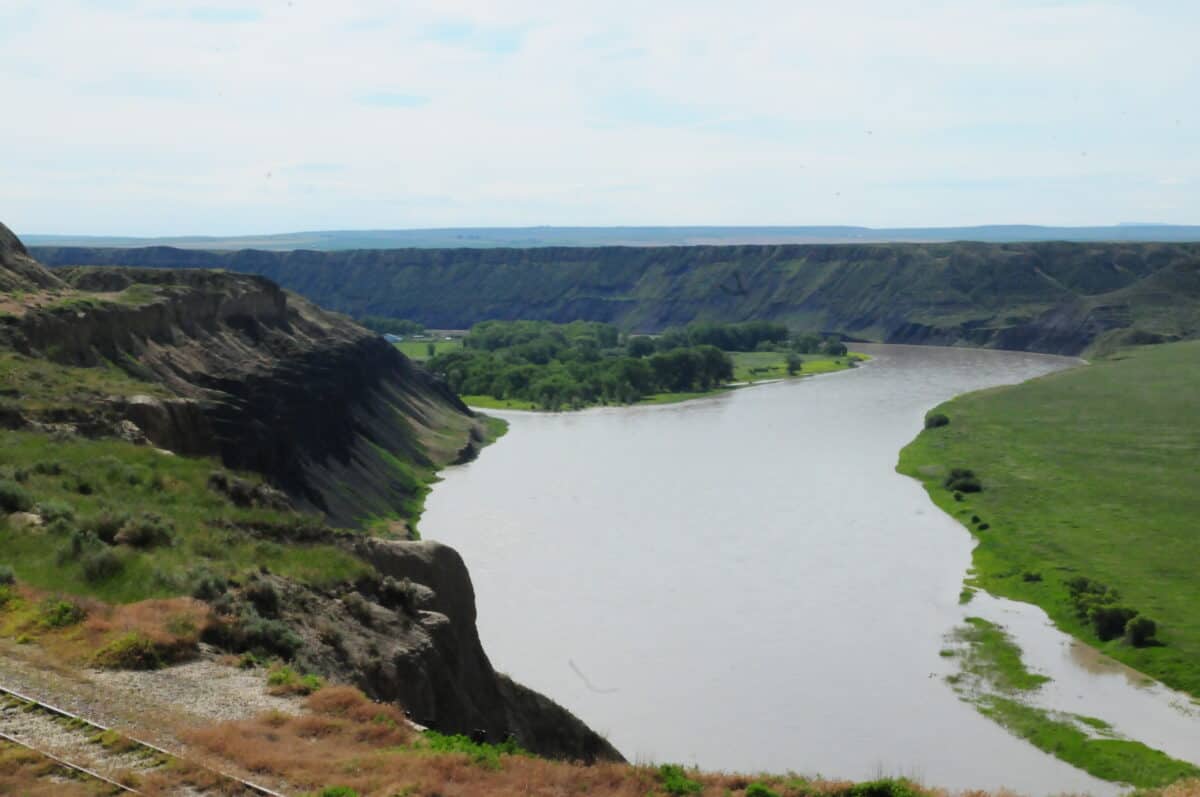
Initially, it was very complicated and expensive to travel west from the Eastern United States to Montana. It took weeks and months. Some traveled by steamboat from St. Louis up the Missouri River as far as Fort Benton, Montana. From Fort Benton they continued south by stagecoach or wagon to the gold fields. This route was time-consuming. “Since Montana was not really close to anything of note, the miners were continually plagued by inefficient, seasonal freight service, and, of course, exorbitant prices for any imported commodity.”[6] Freight companies out of Omaha, Nebraska, began doing business with some of the emerging Montana cities in 1863, places like Bannack, Virginia City, Louisville, and Forest City.
Mining centers became ghost towns
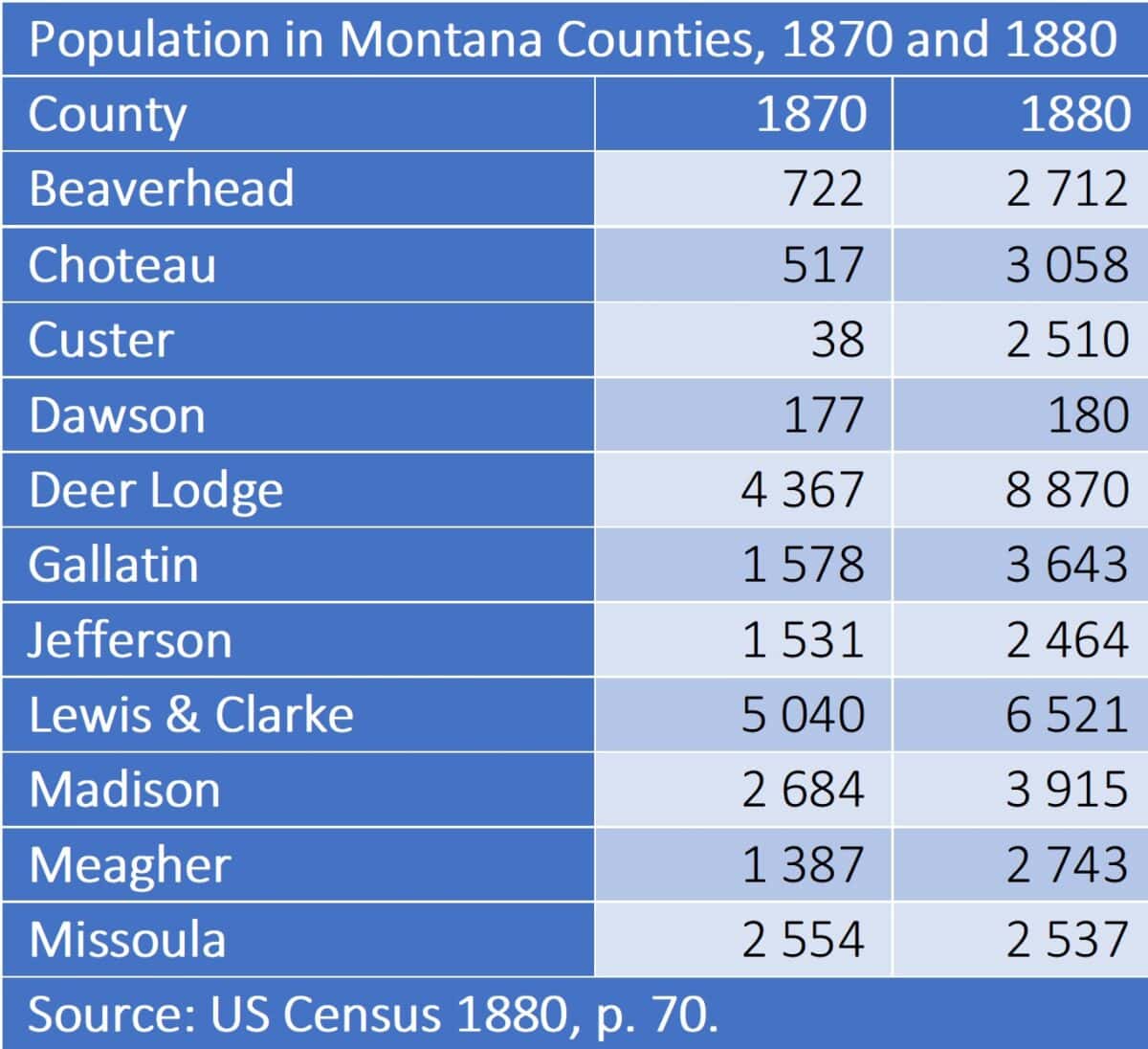
When placer gold mining declined, former mining centers became ghost towns. Men were quick to move in and out of mining camps. Moving from one camp to another they learned a lot about other resources in the Rocky Mountain region. Among the men who had saved money from placer mining, some chose to stay in Montana and invested their money in livestock, agriculture, and commerce.[7] Places like Missoula, Deer Lodge, Helena, Bozeman, and Spokane grew in step with increasing production and trade.
Norwegian immigrants were also attracted by gold mining
The Montana Territory had seven counties in 1870, located in the western and central parts of Montana. The counties with the highest population were all dominated by mining. In 1870 20,595 persons lived in the Territory. Of them only 88 persons were immigrants born in Norway. The highest numbers of Norwegians and Swedes in Montana in 1870, counted together, lived in Lewis & Clark County – a total of 66, while 43 Norwegians and Swedes lived in Deer Lodge County, and 33 in Jefferson County.
Between 1870 and 1880 the population of Montana almost doubled to 39,159 inhabitants. The highest number of Swedes and Norwegians in 1880 lived in Deer Lodge County (111), Lewis & Clark County (96) and Jefferson County (49).[8] Both in 1870 and 1880 mining was the main economic activity in these counties.
The 1880 and 1890 Census
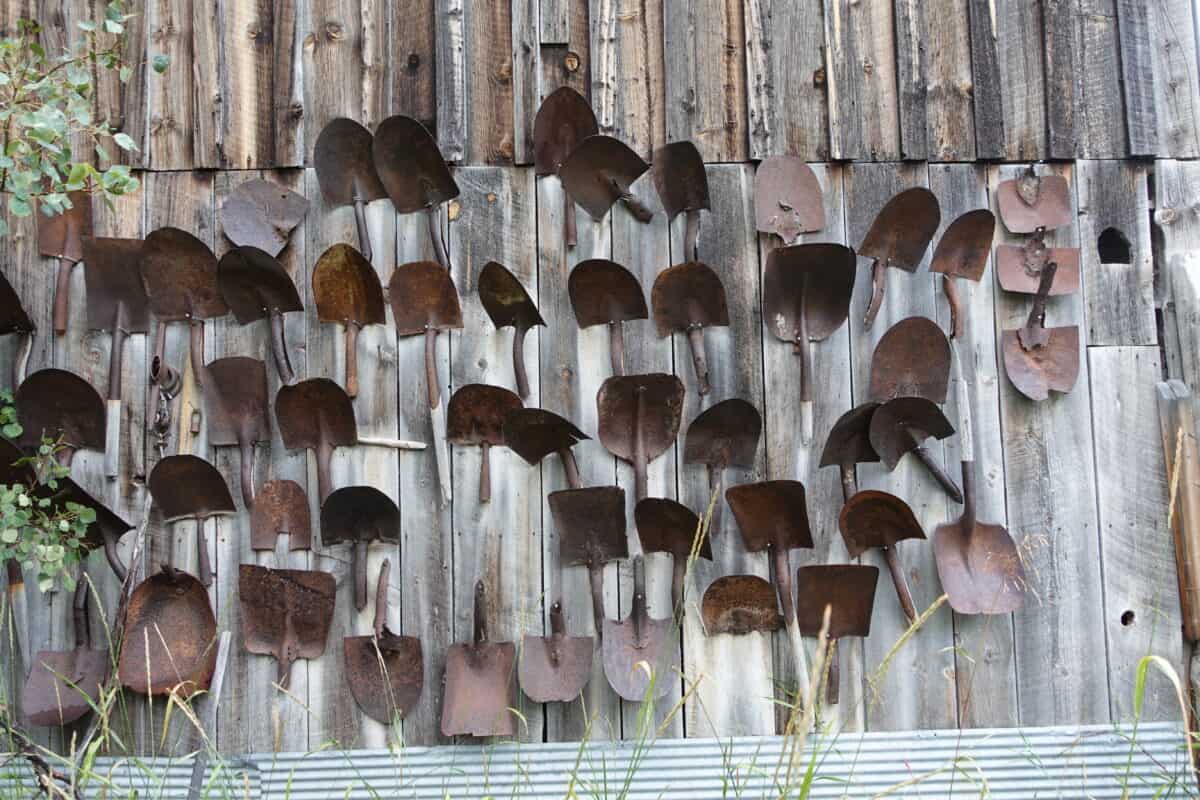
The 1880 Census registered 1,957 persons who had emigrated from Norway, 3,771 from Sweden, and 683 from Denmark. The largest number of Norwegians in 1890 lived in the following Montana counties: Cascade (464), Lewis and Clark (311), and Missoula (207) followed by Silver Bow (167), Park (140), Meagher (111), Custer (106), Deer Lodge (92) and Choteau (88).[9] From the late 1880s the construction of copper refineries, and work related to these refineries in Great Falls, Cascade County, attracted many Norwegian immigrants. Lewis & Clark County was still a leading mining county, and copper mining in Butte and Anaconda in Silver Bow County was growing fast.
In his classic book from 1938, Norwegian Settlement in the United States, the author Carlton C. Qualey discusses thoroughly where Norwegian-Americans settled during different decades. In a chapter on “North Dakota and Beyond”, Qualey observed that “Norwegian settlement extended naturally into the eastern counties of Montana.”[3] Among Norwegians who crossed the western boundary of North Dakota into eastern Montana before 1900, many first settled in Dawson and Custer counties. Some of them moved from farms in the Red River district in eastern North Dakota, and some emigrated directly from Norway. According to Qualey the 1900 US Census only registered 371 Norwegian immigrants in eastern Montana.
The railroad brought population growth
The railroad created considerable population growth in Montana, beginning from 1860. The earliest and most important railroad in Montana was the Northern Pacific Railroad. It reached Glendive and Miles City in Eastern Montana in 1881 and Billings in 1882. During the 1880s the population of Montana increased by 265 per cent, to 142,924 persons in 1890; of them 43,096 persons or 30 per cent were foreign born.
Even at the time of the US Census in 1900 only a total of 4,764 Norwegian immigrants lived in Montana; 2,487 were born in Norway, 1,228 in Montana, and most of the others were born in Utah and eastern states. The largest number of Norwegians lived in western and central Montana, in counties like Cascade (including the city of Great Falls), Carbon, Choteau, Deer Lodge (Anaconda), Flathead, Silver Bow (Butte), Sweet Grass and Lewis and Clark (Helena).[10] Norwegian settlers at the turn of the century still mostly lived in or around cities and mining communities.
The increase of the Norwegian population in Montana between 1910 and 1930
According to Carlton Qualey, the Norwegian element in Montana was never very large. Norwegian immigrants accounted for only 1.9 per cent of the total Montana population in 1910. In 1930, however, the percentage of Norwegians reached 5.4 per cent of the total population and was now 29,387 people.
Far from all worked in mining. About a third lived in agricultural counties in the northeast. In northern Montana the Great Northern Railway opened a whole new region for homesteaders. The last spike was driven on January 6, 1893, at the west portal of the Cascade Tunnel. A month later the first trains began to run, but the first through passenger train did not leave St. Paul, Minnesota, for the Pacific Coast until June 1893.[11]
In addition to immigrants who arrived directly from Norway, many Norwegians moved to Montana from the Midwest. Many among them were second-generation Norwegians who had grown up in Wisconsin and Minnesota. The total number of Norwegian-Americans in Montana was in fact much higher than we can read from the census numbers. These second-generation Norwegians frequently migrated to Montana from the Midwest during the last decades of the 19th century.
Why did the Norwegians settle where they did?
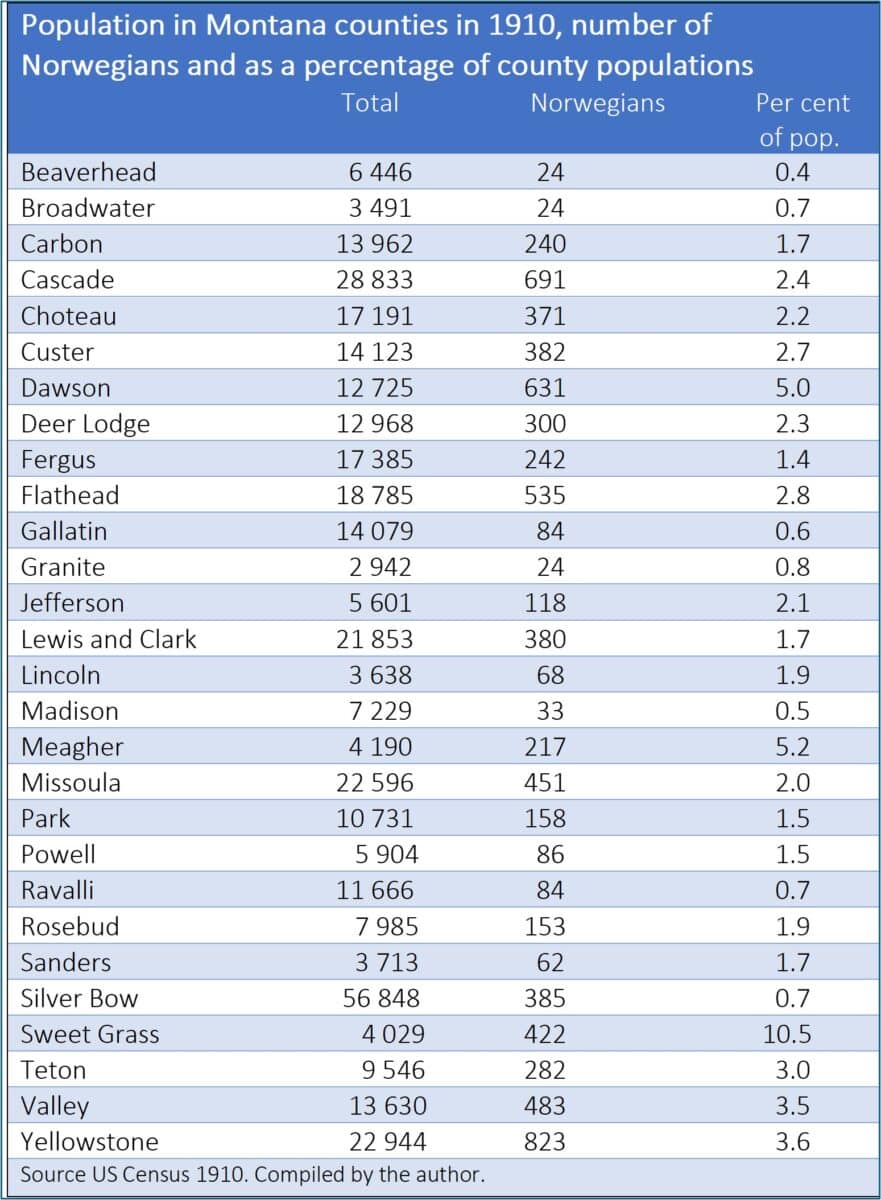
The railway bought its lands from the federal government. It received no land grants, and the land was resold to individual farmers. The Great Northern Railway operated sales agencies in Germany and Scandinavia and subsidized the travel expenses of whole families. Many Norwegian immigrants after 1900 settled in counties along the railway line – from Sheridan County in the east, just across the North Dakota border, and Daniels, Valley, Phillips, Blaine, Hill, and Liberty counties further west.
Increasing number of Norwegians settled along the eastern border of Montana – in Roosevelt, McCone, Richland, Dawson, Prairie, Wibaux, and Custer counties.[12] “By 1930, the Norwegians in these counties, including both foreign- and American-born persons, numbered at least 11,168. Within the boundaries of the United States, the settlements in northeastern Montana form the northwesternmost point to which the Norwegians advanced in their march from the southern tip of Lake Michigan.”

Credits
All tables are compiled from official records by Gunnar Nerheim (c).
Images (c) Inger Kari Nerheim.
Notes
[1] Utvandringsstatistikk, Norwegian Official Statistics, VII 25, Indredepartementet, Kristiania, 1921, pp. 5-6.
[2] Kenneth S. Bjork, West of the Great Divide, Norwegian-American Historical Association, Northfield, Minn., 1958, p. vii.
[3] Qualey, Carlton C., Norwegian Settlement in the United States, NAHA, Northfield MN, p. 170-171, 1938.
[4] Burlingame, Merril G., The Montana Frontier, Helena 1942, reprinted by Big Sky Books, Bozeman, 1980, pp. 78-100; K. Ross Toole, Montana. An Uncommon Land, University of Oklahoma Press, Norman, Oklahoma, 1959, pp. 64-94; Michael P. Malone & Richard B. Roeder, Montana. A History of Two Centuries, University of Washington Press, Seattle, 1976, third printing 1988, pp. 50-69.
[5] Ken Robison, “Completing the Mullan Road from Mullan Pass to Fort Benton: A Harbinger of Change”, in McDermott, Grim and Mobley (eds.), The Mullan Road. Carving a Passage through the Frontier Northwest, 1859-62, Missoula, Montana, 2015, pp. 131-151.
[6] Carlton Qualey, Norwegian Settlement in the United States, Norwegian-American Historical Association, Northfield, MN, 1938, p. 170.
[7] S. J. Coon, “Influence of the Gold Camps on the Economic Development of Western Montana”, Journal of Political Economy, Vol. 38, October 1930, pp. 580-599.
[8] Grimsby, Oscar Melvin, “Contribution of the Scandinavian and Germanic People to the Development of Montana” (1926), Grad. Stud. Theses, Dissertations, & Professionals’ Papers. 5349. http://scholarworks.umt.edu.etd/5349, https://scholarworks.umt.edu/do/search/?q=Oscar%20Melvin%20Grimsby&start=0&context=4678273&facet=; pp. 75-76.
[9] Grimsby, op. cit., p. 76.
[10] Qualey, op. cit., p. 195.
[11] Martin, Albro Martin, James Hill and the Opening of the Northwest, Minnesota Historical Society Press, St. Paul, Minnesota 1976, pp. 392-398; Malone, Michael P., James Hill. Empire Builder of the Northwest, University of Oklahoma Press, Norman, Oklahoma, 1976, pp. 102-150.
[12] Qualey, op. cit., p. 171.
Views: 243
